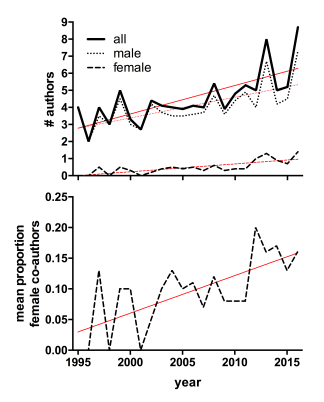 It was with some consternation that I processed some recent second-hand scuttlebutt about my publishing history with respect to gender balance. I’ve always considered myself non-sexist when it comes to working with my colleagues, but as a white, middle-aged male, I’m willing to admit that perhaps subconsciously I’ve been promoting gender inequalities in science without realising that I’m doing it. As a father of a daughter, I also want to make sure the world in which she grows up isn’t as difficult as it has been for women of previous generations.
It was with some consternation that I processed some recent second-hand scuttlebutt about my publishing history with respect to gender balance. I’ve always considered myself non-sexist when it comes to working with my colleagues, but as a white, middle-aged male, I’m willing to admit that perhaps subconsciously I’ve been promoting gender inequalities in science without realising that I’m doing it. As a father of a daughter, I also want to make sure the world in which she grows up isn’t as difficult as it has been for women of previous generations.
It is still an unfortunate fact that the ideal of a 50–50 gender balance in the biological sciences is far from becoming a reality; indeed, women have to be about 2.2-2.5 times more productive than their male counterparts to be as successful in securing financial support to do their work.
In fact, a 1993 study of ecologists attributed the lower (but happily, increasing) productivity and dwindling representation of women with career stage to such institutionalised injustices as: less satisfactory relationships with PhD advisors, difficulty in finding suitable mentors, lack of institutional empowerment, greater family responsibilities, lower salaries, lower job security, and lower evaluation of personal success. A follow-up study in 2012 suggested that the gap was narrowing in many of these components, but it was still far from equal. For a more comprehensive discussion of the complexity of the issues in science (see here), and in ecology in particular, see here.
Others have more recently reported no evidence for a gender effect in paper acceptance rates (Biological Conservation), and no difference in the level of perceived expertise between men and women (in long-term environmental or ecological research at 60 protected areas stratified across forests of the Asia-Pacific, African and American tropics).
But my accusation wasn’t specific to any of these components — it was more about the people with whom I choose to work and publish. Despite looking1, I really couldn’t find any information on the distribution of co-authorship gender ratios in my (or any other biological sciences) discipline. I now realize why — it is a massive undertaking to calculate.
Although it took me several days, I went back through all of my published papers (including a few that are in the final stages of review that should be published this year) to examine the ratio of women:men with whom I’ve published. This was no quick task.
 Of the 258 papers I’ve published, I worked out that I co-authored them with 644 different scientists, of which 172 were women and 472 were men (27% women). Interestingly, I also calculated that I have published with 337 different people that I have not yet met in person (the wonders of the digital age) — but I digress.
Of the 258 papers I’ve published, I worked out that I co-authored them with 644 different scientists, of which 172 were women and 472 were men (27% women). Interestingly, I also calculated that I have published with 337 different people that I have not yet met in person (the wonders of the digital age) — but I digress.
I didn’t think 27% sounded too bad, but when I looked for some sort of baseline to which I could compare my history, I found nothing about publication gender ratios that was immediately obvious. The closest I managed to find as some sort of baseline expectation was for evolutionary biologists in three different stages of career (% women as fellows, lecturers and professors in top-10-ranked evolutionary biology departments: 25-49%, 28-54% and 12-33%, respectively) (Fig. 4 in this paper). That’s not exactly a comparable baseline, but if you consider that I’m publishing mostly with students and early-career people, I’m probably not far off these percentages.
However, my track record isn’t as good when you look at the distribution of gender ratios across my papers. Including myself, the mean proportion of women with whom I publish per article is only 15%. Even though the average number of authors/paper is increasing as I advance in my career, I am at least happy to conclude that the proportion of women co-authors is rising (see figure above): I have increased from a mean per-paper percentage of ~ 3% women in 1995 to ~ 16% women in 2016.
It would be good to know where I stand relative to other males of my age and experience in this regard, but so far I have yet to find the data. If you do know, please let me know. In the meantime, I’ll try to be more active about gender equality in my publishing.
1I probably didn’t do a completely thorough literature search, but I did spend several days perusing Google Scholar.

